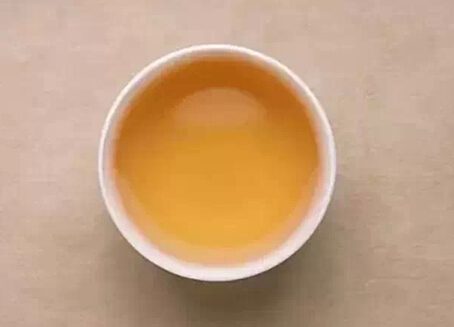
The step of 'appreciating the soup color' is particularly interesting.
Because the tea polyphenols in the tea soup will quickly oxidize when exposed to air, causing the tea soup to change color easily, it is important to appreciate the soup color in time. This mainly involves distinguishing the depth of the tea soup color, whether it is normal or not, the brightness or darkness of the tea soup, and the degree of clarity or turbidity from the aspects of hue, brightness, and clarity.

Why is some tea soup green and some red, some bright and some dark?
Answer: The color of tea soup can also be judged by hue, brightness, and chroma.
Hue refers to the type of color. The color of tea soup mainly changes between green and red, which is related to the degree of fermentation of the tea. The less fermentation, the more the soup color tends to be green; the more fermentation, the more it tends to be red. There are non-step changes such as yellow-green, golden yellow, and orange-red in between.
Brightness refers to the lightness or darkness of the color, which is related to the degree of roasting of the tea. Tea that has not been roasted much has a bright soup color. After roasting, as the degree of roasting increases, the soup color becomes darker and darker.
Chroma refers to the saturation of the color, which is related to the amount of soluble substances in the tea soup. The more soluble substances are dissolved, the thicker the tea soup becomes, which is manifested as high chroma in the soup color. Conversely, the fewer soluble substances, the more watery the tea soup becomes, and the lower the chroma of the soup color.

Common terms for evaluating the color of tea soup:
Green and gorgeous: clear and bright, light green and vivid.
Yellow-green: green with a slight yellow, similar to the color of a semi-ripe orange, hence also called orange-green.

Green-yellow: green with more yellow in the soup color.
Light yellow: the soup color is yellow and light, also called pale yellow.

Orange-yellow: the soup color is yellow with a slight red, similar to orange or tangerine yellow.
Orange: the soup is red with yellow, similar to tangerine red.

Deep yellow: dark yellow, the soup is yellow and deep without gloss.
Blue-dark: the soup color is bluish without gloss.
Turbid and dark: the soup color is turbid and dark, synonymous with 'turbidity'. There are many precipitates in the soup, turbid and unclear, making it difficult to see the bottom of the bowl.
Red soup: commonly seen in aged tea or tea that has been over-roasted. The soup color is light red or dark red.
Clear yellow: the tea soup is yellow and clear.

Golden yellow: the tea soup is clear, mainly yellow with orange.
Red and gorgeous: soup color like amber with a golden edge, which is the soup color of high-grade black tea.

Red bright, red clear: the soup color is not very strong, but red, transparent, and lustrous, called 'red bright'; transparent but slightly less lustrous, called 'red clear'.
Deep red, deep and strong: red and deep, lacking bright luster.
Light red: the soup color is red and light.

Deep and dark: the soup color is deep and dark, slightly black, also called red dark. This color often appears when black tea is over-fermented or stored for too long, and the quality has aged.
Red turbid: regardless of depth or lightness, the soup has many precipitates and is turbid, making it difficult to see the bottom.
Cooling turbidity, cream凝结: when black tea soup is strong, after cooling, a light brown or orange milky turbidity phenomenon appears, called cooling turbidity or cream凝结. This phenomenon occurs in good quality black tea.

Ginger yellow: after adding milk to broken black tea soup, the soup color becomes ginger yellow, bright, thick, and full. It is a sign of strong soup quality and good quality.
Strong and bright: the tea soup is strong and transparent. Although not as bright as strong and gorgeous, it still has luster.

Vivid: fresh and bright, slightly glossy, not strong but not weak either.
Clear, bright: the tea soup is clean and transparent, called 'bright'. Bright and glossy, able to see the bottom at a glance, without precipitation or suspended matter, called 'clear'.
Clear and clean: the substances in the soup are not rich, but still clear.
Turbid: there is a large amount of suspended matter in the tea soup, poor transparency, making it difficult to see the bottom of the bowl.
Dim: the soup color is not bright, but without suspended matter, slightly different from turbidity.